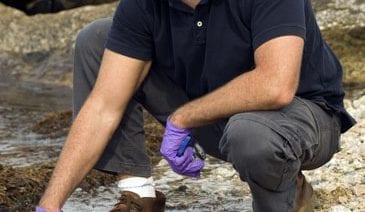Press Room
Were prehistoric horses extinct before humans arrived in Alaska, or were they hunted to extinction by humans? In a recent paper in the Proceedings of the National Academy of Sciences, researchers from WHOI and the United Kingdom applied a statistical…
Dramatic new video of a long-term volcanic eruption in the western Pacific first discovered in 2004 has been captured during a recent cruise by the remotely operated vehicle JASON, developed and operated by WHOI’s Deep Submergence Laboratory. The ROV, capable…
Marine scientists and engineers will brief investors, business development executives, commercialization partners and economic development leaders May 24 at a conference at WHOI aimed at showcasing marine technologies and concepts ready for commercialization or licensing. Among the topics: maritime surveillance…
Trying to figure out what tiny creatures live in the ocean is no easy task, but thanks to technology, patience and hard work, scientists have explored a section of the tropical Atlantic between the U.S. east coast and the Mid-Atlantic…
WHOI biologists and physical oceanographers joined forces in May to study the effect of ocean currents on fish larvae spawned on coral reefs in Belize. Collaboration for the pilot project included the use of an autonomous underwater vehicle (AUV) named…
Why are chickens so sensitive to dioxins, but terns seem much more resistant, despite their exposure through eating dioxin-tainted fish? The life-or-death difference researchers have found can be partially explained by two amino acids in the chain of 858 amino…
The saying “a picture is worth a thousand words” is increasingly true in today’s world as images are used throughout society to entertain, inform and educate. Locating just the right image can be difficult, but thanks to new technology, that…
What do month-to-month changes in temperature have to do with century-to-century changes in temperature? At first it might seem like not much. But in a report published in this week’s Nature, scientists from the Woods Hole Oceanographic Institution (WHOI) have…
ImageSource, a new database of images and illustrations representing years of ocean exploration, is now available to the public. Combining a number of visual libraries and collections at the Institution, WHOI ImageSource was created to provide the interested public with…
Scientists have reported an unprecedented number of unaccompanied and possibly abandoned walrus calves in the Arctic Ocean, where melting sea ice may be forcing mothers to abandon their pups as the mothers follow the rapidly retreating ice edge north. Nine…
Scientists at the Woods Hole Oceanographic Institution (WHOI) have completed two extensive survey and mapping efforts to better understand why the 2005 New England red tide was so severe and to suggest what might lie ahead. WHOI Senior Scientist Don…
A 12-foot Cuviers beaked whale (Ziphius cavirostris) found stranded on a beach south of Boston in early April is a rare event in New England, although strandings of pilot whales and other marine mammals are not unusual. In collaboration with…
A new cabled observatory off the island of Canales de Tierra is the latest in a series of underwater laboratories that can monitor marine ecosystems over long periods and transmit live images and data back to scientists around the world.…
In May, the Spray glider will attempt to set yet another record when it will begin the roughly 2,500-mile journey from the tip of Greenland to the coast of Spain to help scientists better understand the role of oceans in…
The Deep Submergence Vehicle (DSV) Alvin finished a five-month overhaul in Woods Hole in early April and returned to sea April 19 aboard support vessel Atlantis for what may be Alvin’s last voyage. The three-person sub, with more than 4,100…
Despite a ship strike that caused significant damage and harsh winter conditions, a surface buoy and mooring have survived a record six months in the Gulf Stream, recording both atmospheric and ocean conditions. The mooring was deployed in October 2005…
Physicist Bill Jenkins, a senior scientist and 32-year veteran of the WHOI Department of Marine Chemistry and Geochemistry, has been named the new director of the National Ocean Sciences Accelerator Mass Spectrometer (NOSAMS) facility. Jenkins is the third director of…
Woods Hole Oceanographic Institution (WHOI) scientist Christopher Reddy has been chosen one of 18 academic environmental scientists from throughout the U.S. and Canada as a 2006 Leopold Leadership Fellow. The Aldo Leopold Leadership Program provides scientists with intensive communications and…
Several hundred WHOI scientists and engineers will join the nearly 3,500 researchers at Ocean Sciences 2006, jointly sponsored by the American Geophysical Union, American Society of Limnology and Oceanography, The Oceanography Society, and the Estuarine Research Federation. Starting February 20,…
Marine scientists and engineers have created a new tool to track an essential ingredient on which life in the oceans depends: iron. The instrument, deployed on a buoy off Bermuda for four months in 2004, collected wind-blown particles in the…

